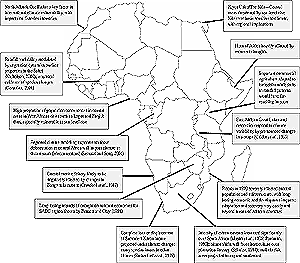|
10.4. Synthesis
Select key impacts over the African continent are highlighted in Figure 10-10.
Water resources are a key vulnerability in Africa for water supply for household
use and for agricultural and industrial use. In shared river basins, regional
cooperation protocols minimize adverse impacts and potential for conflicts.
Land use in many of Africa's large and shared basins has long-lasting impacts
through modifications of the water budget and through chemical and sediment
input into waterways. Water issues in urban and rural areas are likely to become
more critical, given increasing and competing demands, as well as rapid population
growth. Infrastructure to store and serve water in major urban areas is mostly
overstretched in capacity, and extreme events such as floods that cause physical
damage add to the problem. Monitoring of water levels and water use is very
poor and limits analysis of vulnerability.

Figure 10-10: Selected key impacts for Africa. |
There is wide consensus that climate change will worsen
food security, mainly through increased extremes and temporal/spatial shifts.
The continent already experiences a major deficit in food production in many
areas, and potential declines in soil moisture will be an added burden. Food-insecure
countries are at greater risk of adverse impacts of climate change.
Irreversible losses of biodiversity could be accelerated with climate change.
Climate change is expected to lead to biome shifts, with drastic shifts of biodiversity-rich
biomes such as the Succulent Karoo in South Africa, and many losses in species
in other biomes. Analysis of potential biome shifts is possible in areas where
good spatial databases of vegetation and biophysical variables and land use
are available. It is expected that these analyses will improve as more data
are available from new and better satellite sensing systems, as well as coordinated
field studies in shared resource areas.
Changes in temperature and rainfall will have many negative impacts on human
health. Changes in disease vector habitats will expose new populations to diseases
such as malaria. Droughts and flooding, where sanitary infrastructure is inadequate,
will result in increased frequency of water-borne diseases. Increased rainfall
could lead to more frequent outbreaks of RVF. Many African nations do not have
adequate financial resources for public health.
Sea-level rise, coastal erosion, saltwater intrusion, and flooding will have
significant impacts for African communities and economies. Most of Africa's
largest cities are along coasts and are highly vulnerable to extreme events,
sea-level rise, and coastal erosion as a result of inadequate physical planning
and escalating urban drift. Rapid unplanned expansion is likely to predispose
large populations to infectious diseases from climate-related factors such as
flooding.
Desertification is a critical threat to sustainable resource management in
arid, semi-arid, and dry subhumid regions of Africa, undermining food and water
security.
A diversity of constraints facing many nations limits overall adaptive capacity
for Africa. Although there is uncertainty about what the future holds, Africa
must start planning now to adapt to climate change. Current technologies and
approaches—especially in agriculture and water—are unlikely to be
adequate to meet projected demands, and increased climate variability will be
an additional stress. It is unlikely that African countries on their own will
have sufficient resources to respond effectively.
Climate change also offers some opportunities. The processes of adapting to
global climate change, including technology transfer and carbon sequestration,
offer new development pathways that could take advantage of Africa's resources
and human potential. Regional cooperation in science, resource management, and
development already are increasing, and access to international markets will
diversify economies and increase food security.
|